The Maypole Beerhouse, Aspley Hill, Woburn Sands
What we now know as No. 3, Aspley Hill, was once “The Maypole” beerhouse. The late Arthur Parker researched the Maypole, and his research is below, augmented by what I have found out since, from newspapers of the day and other sources that Mr. Parker had no access to when he did his research.
This beerhouse probably had the shortest life of any of our inns, as it only ran for 63 years. From the deeds of the property, Parker states that in 1859 the site had on it two cottages, but by 1872 The Maypole had been erected by the Fowler brothers, brewers at Woburn. It was later held by William Goodman, the Eversholt farmer, who lent money on a number of other properties in Woburn Sands. He had apparently leased the premises to Fowler in 1865, provided they pulled down the cottages and erected the new public house, so it can be dated from that year. Goodman regained possession of the property in 1875.
As with most inns and beerhouses of this time, the usual reason they appeared in the local newspapers was as the location of some kind of disturbance. I’m sure that inbetween these events, it was a centre of community and good nights out for the locals! The first newspaper report I can find connected to the Maypole is in the Leighton Buzzard and Linslade Gazette (LB&LG) of 16th February, 1869. It records that George Goodhall, the local timber dealer, had been charged by William Griffin of assaulting him at the Maypole beerhouse. Griffin said that Goodhall wanted a fight, and when Griffin refused, Goodhall had struck him anyway. John Collins, the baker, witnessed this version of the assault. Goodhall swore that Griffin had taken off his shirt and was already fighting with Goodhall’s brother, so George had stepped in to break it up. George had his own witness, James Smith. The Judge disbelieved their stories and dismissed the case.
The LB&LG again, 12th August 1873: “To Be Let. The Maypole, Woburn Sands, doing a Good Trade, which has been very much increased. Possession at Michaelmas next. Apply to Henry Fowler, The Brewery, Woburn.”
Another small piece in the paper in June 1874 records that the licence for the beerhouse was endorsed to Arthur Jenkyns to carry on business until the next transfer day in July. Perhaps a tenant had left and he was a stand-in manager? By September, the paper reported that the licence had transferred from John Collins (the same baker as witness in the Goodhall assault case?) to John Scott.
More trouble occurred in March, 1877, when the local chimney-sweep of Aspley Guise, Frederick Whitlock, came into the house already drunk and was abusive towards Mrs Scott for refusing to serve him. A policeman was called, who threw him out, and charged him with refusing to quit licensed premises. At the court case, P.c. Whinnett said he could hear the commotion from outside the beerhouse. The judge, Lord Charles Russell said the innkeeper should not have let him into the house in the first place, but Mrs Scott said he had slipped in the back way before they knew how drunk he was. Whitlock claimed to have sunstroke from a recent visit to America(!) and that beer now affected him badly. He was fined £1, and 10s. costs, of which he was 3s. short, and he amused the Court by appealing to Mrs Scott to pay it for him! She declined, and he was given till 4pm that day to present it to a police station.
The inn also acted as a meeting place, and must have had a fairly large room available as was the scene of local inquests, such as that for Jonathan Puttman, the local blacksmith who committed suicide in July 1879. He had recently retired, and handed his business over to his nephew, Mr Rice. Retirement bored him, and he had lately been depressed according to his family. He was found hanging in his own stables. Mr Wiseman, deputy coroner presided over the inquest, and they decided on “Suicide while in a state of temporary insanity”.
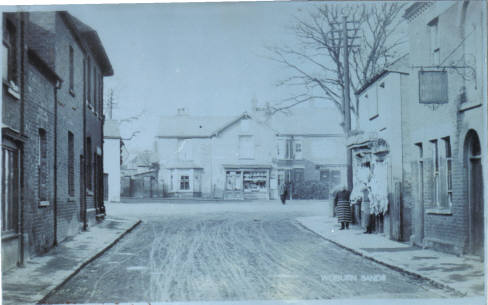
In March 1881, the Woburn Brewery belonging to the Fowlers was sold, and the Maypole was one of 24 freehold inns sold at the same time. Sadly, the buyer is not recorded in the newspaper. In June that year, the landlord changed again. Mr & Mrs Scott left, and, according to the LB&LG Ebenezer “Ankins” took over. It seems to be “Hankins” in all other records. Perhaps it was spelt how the reporter heard it in Court! Certainly they had his name correct when he was charged with permitting drunkenness in May 1882, and he was fined 2s with 18s costs.
Later that summer, Hankin was back in Court, but this time in a case against a tramp who had stolen £3 10s 6d from him in November the year before after spending the night at the inn. At that time, the tramp had got away with the money, but now he had travelled back through Woburn Sands and was recognised and caught. He was sentence to 3 months’ hard labour.
Parker says that William Goodman sold the beerhouse to Charles Wells, the Bedford brewer, in 1881, and it was certainly Wells by April 1883, as they were advertising it to be let. By the end of the year, Hankin had gone and now John Clark was in charge.
In December 1885, George Labrum was another local man on a “refusing to quit” charge. In November, he had got into an argument “…about the election, and he became excited”. Fined 2s 6d with 8s 6d costs. He swore it would not happen again….
It’s nice to see some positive news for a change, when landlord Clark and his wife had a son in February 1886, but the next article is another criminal case. In the Beds Times of May 5th, 1888, William Warner, a butcher from Ridgmont, had been drinking in the Maypole, but had no place to sleep. He was kindly offered a bed for the night by Thomas Devereux of Aspley Heath. Alas, when Thomas awoke, William was gone, along with Thomas’ German silver watch, attached to a brass chain, with a silver bell, a gold seal, and two keys. Some of the items were tracked down to the landlord of the Boot Inn in Kempston, and Warner was arrested in Bedford. Fined £1 or 14 days heard labour, Williams father was in Court and paid the fine for his son.
Before the year was out, there was more trouble. Charles James White, of Woburn Sands, was charged by John Clark with having broken a window on the 21st December. Clark said White came into the house wanting fight, and Clarke put him outside, whereupon he smashed a large pane of glass in the door. White had not arrived in time for his court case, but staggered in halfway through, “…waving his hat and splattered with mud…” He was committed for 14 days, after failing to pay the 15s. 8d. for fine, costs, and damage.
It would appear Clark had had enough of the inn, as by April the next year, there was a new landlord, Joseph Chantler. This is recorded when a horse he had rented out took fright and bolted along with the cart of fagots attached to it. Chantler’s horse had to be put down, as it had injured itself attempting to jump a gate.
There is then a six-year jump before the next article about the Maypole appears, during which time Chantler had gone, George Kilsby had come and gone, and now George Webb and his wife Mary Ann were in charge. This comes from the Beds Times of 15th September, 1894: “A painfully sudden death occurred at the Maypole Inn, Friday, the deceased being an elderly man named Thomas Williams, an iron and metal dealer, of Hitchin. It appeared that the deceased had been staying at the Maypole for some few days, and on Wednesday complained of feeling unwell, but appeared to rally as turpentine had been applied to his side, where he said the pain was. He continued in the same state of health until Friday, when between four and five o’clock in the afternoon, he was about to partake of some slight refreshment, but suddenly fell back the chair in which was sitting, and expired before medical aid arrived. The inquest was held Saturday, at the Maypole, before the district Coroner, Mr. F Tanqueray. The jury was composed follows: Messrs. E. G Miller (foreman), G. Day. G. Tansley, T. Chisnall, J. Wright, Bodsworth, Hewling, Webb, Bowler, Goodger, Burt, and Sinfield. Evidence was given by Isaac Williamson; Mrs. Mary Webb, wife of the landlord of the house and Brander, and a verdict of ‘Death from natural causes’ was returned.”
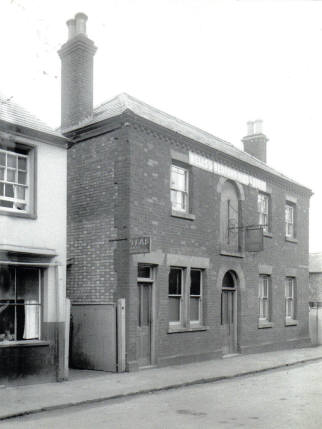
There are more stories concerning the inn before the end of the year. Mr Robert Hammond, late coachman for the Duke of Bedford, had retired to a cottage in Cheapside, as the area around The Maypole at the bottom of Aspley Hill was known. He died aged 73, and was found dead at home after not being seen for a few days. He was last seen alive in the Maypole, taking a bottle of beer home with him.
…and this piece from the Beds Times again, same year, 24th November:
“Guy Fawkes Day at Aspley. At the [Woburn] Petty Sessions held on Friday morning before Mr. C. P. Stuart (chairman) and Major Downes. Hugh King, a plumber, of Ampthill, was charged with assaulting Wm. Giles, a plasterer, Aspley Guise, on Nov. 5. Complainant stated that he was in the Maypole Inn, when a firework exploded in the passage of the house; defendant came out of the bar, knocked him down a step, and struck him twice in the face with his fist. Complainant exploded two fireworks in the room, but denied letting the one off in the passage. The charge against defendant was dismissed after a great deal of evidence, and Giles was ordered to pay the costs 16s.”
In December, Webb was in Court charged with indecently assaulting and ill-treating a girl younger than 13-year-old, from Aspley Guise. She was staying with her sister and another girl at Mrs Dolton’s, who were described as “boarded out children from London”. While the other girls were doing errands, Webb took one of them into a field and kissed her, and then offered her a shilling. All three girls gave clear accounts of the events, and were very distressed, and other witnesses confirmed Webb had been with them, including the landlord of The Steamer beerhouse in Aspley Guise. He was committed for trial at the Bedfordshire Assizes, on £60 bail. Although out on bail, he was out of a job and home, as just four days later, the inn was being advertised to be Let by Charles Wells in the Beds Times.
When the Assizes were held in February 1895, it was found that the charge against him had been entered as ‘committing acts against a girl over 13 but under 16’, when she was actually under 13. The Judge was scathing about how such a mistake could have been made in the paperwork. Once the trial started, the girls gave the same evidence again, and then the defending barrister gave details of Webb’s 21-year Army career. Webb provided an alibi for himself, saying he was at home at the time of the events. The jury then acquitted him.
Another inquest was held at The Maypole in February 1895, on the death of Cecil Robert Bazley, the seven-year-old son of William Henry Bazley. His mother had brought him downstairs for breakfast to get ready for Sunday school, then gone back up to fetch her baby. When she came back, her son was on fire, even though their open fire had a guard around it. Mr & Mrs Bazley managed to get the flames out, but he died the next day. There were many deaths of children from fires at that time.
The LB&LG reported that many of the same coroner’s jury were back at the inn in July for an inquest on George Seabrook, a 69-year-old sawyer of Aspley Hill, who had hanged himself from an apple tree in his neighbour’s garden. His wife said he had suffered from a very bad pain in his head for several months past, and had that morning said he could not live any longer with it. The newspaper also pointed out that there had been four inquests at The Maypole in the last 10 months for people who lived on Aspley Hill, all within 100 yards of each other, and all from the same side of the street.
In October, there is a long report of a family argument which ended up in Court. Joseph Page of Aspley Guise was accused by his own father of threatening him in The Maypole. There had been a simmering family feud for many months, and Page snr. had complained to their joint landlord to get Page jnr. removed from a house next to his. It mentions that they lived in houses along a narrow lane known as the “Jetty”. With claim and counter claim muddling the case, and witnesses on both sides, the judge threw the case out.
Another case about an argument in the street outside the Maypole in November 1896, between John Giles, sawyer, and E G Miller, printer and secretary of the local branch of the National Deposit Society, includes the name of George Woodhams as landlord. He had arrived sometime in 1895.
On 23rd December 1898, the licence of the Maypole Inn was transferred from Woodhams to John Williams, late of Harpenden. Parker says John Williams was the mailman, fetching the letters from Bletchley in his mail cart, and delivering them to the post offices in the villages around.
In the late 1990’s, I was in contact with Mr. Tony Williams, a grandson of John Williams, and whose Uncle Arthur was just 12 when he left Woburn Sands. Arthur was then still alive, although he passed away in 2004.
Tony Williams: “My uncle remembers that the bar of the “Maypole Inn” was decorated with many examples of the taxidermist’s art; a fox, several native animals, and various birds. The patrons were partial to playing skittles. Sing-a-longs were also popular. My grandmother and a couple who were her friends and who had a small shop opposite the school, were the song-leaders. ‘Burlington Bertie from Bow’ was apparently a great favourite.
A Mr. Genge (spelling uncertain) conducted the butcher’s shop. My uncle said that cattle and sheep were herded along the street, and then into a yard behind the Inn where they were slaughtered. He recalls the names of three families that lived in the cottages adjacent to the Inn. There were the Cox, Barton, and Giles families.
There was a ‘festival’ held in the Square which was attended by many visitors (he thinks many came from the industrial cities). These arrived by train, and then caught horse-drawn buses. Foot-races were one of the many activities. [I wonder if this was the 1911 Coronation Celebrations?]
Down Aspley Hill lived a bootmaker who had lost both legs. At the bottom of the Hill, there was a water-driven flour mill, operated by the Summerford family.
He remembers many forests and woods around the village in which they played as boys. Collecting bird’s eggs was popular. During the Great War, a group of Canadian lumberjacks arrived in the village and virtually wiped out one of the bigger woods south of the village. The timber was for use in France, presumably. There was a steam powered saw-mill in Russell Street.
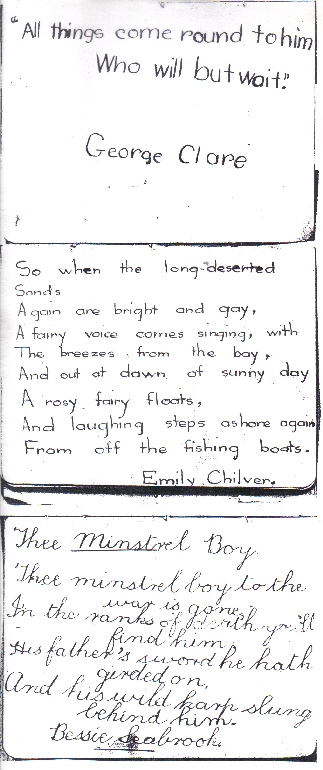
Occasionally, he would go with an elder brother to poach pheasants on the estate of the Duke of Bedford. My grandmother made him attend church twice each Sunday. Apparently, the tedium of church going was relieved when he had to pump the bellows for the organ. I have a bible and a prayer book given to my father. The former by J. Pikesley in remembrance of Confirmation in April 1907, and the latter given by Miss Wing in December 1905.”
When Arthur Williams left Aspley Heath School, all his classmates wrote notes to him in a notebook, which he treasured all his life, to such an extent that when he passed away, his family included it in his cremation. Fortunately, Tony had copied these messages for me some years before, and they come from almost every well-known village name at that time: Leadbeater, Farmer, Jackson, Inwood, Seabrook, Giles, Capp etc. Each has written a short verse of poetry or their best wishes for his future life, in beautiful handwriting.
During the Williams’ tenure, the odd case of drunkenness continued (Harry Sinfield in April 1904) but he started up a Sick and Dividend Club at the inn. Members paid in a small amount each week, which they could draw on if sick and unable to work. These were very popular at the time, when relief from the Church was dying out, and state benefits had yet to be organised. In December 1906, Williams organised an hour’s extension for his Club supper, where “about 50 members partook of an excellent spread. After dinner, Mr Whitlock, the secretary, presented a balance sheet, making several explanations which were all of a satisfactory character, and announced that each member would receive a dividend of 19s 8d.”
There is then a large gap in press reports until the report of a skittles match against the Dukes Head, Aspley Guise in March 1913.
John Williams died in August 1918, aged 60, after what the Beds Times called “a long and painful illness” but no details of what the illness was are given. He was buried at St Michaels, and the Maypole Sick and Dividend Club, for which he had been treasurer for nearly 20 years, were represented by Charles Gooding and Frank Woods.
After John died, his widow Madeline ran the inn by herself for another three years. When she left the inn in 1921, she sold up all her belongings, and emigrated to Australia, settling in Grenfell, about 200 miles west of Sydney. She purchased a piece of land, and erected a cottage, which she called “Woburn”. The advert for the sale of goods from the inn runs as:
“Maypole” P. H. Aspley Hill, Woburn Sands. 1 mile from Woburn Sands Station LNWR. Wallace A Foll (Foll & Bawden) will sell by Auction on Wednesday Nov. 30th, 1921, at One o’clock, by direction of Mrs M Williams who is going abroad: Furniture, including bedsteads and bedding, mahogany marble topped wash stands, mahogany toilet glasses and dressing tables. Antique mahogany bow front chest of drawers, oval mahogany table, glazed walnut cabinet, 2 gilt mantel mirrors, 2 couches, marble clocks, Full Compass Piano in walnut frame by Normelle, London; antique wheel barometer in mahogany frame, war trophies, china, glass, pictures, Windsor arm and other chairs, stained frame dining table 3ft 3in by 6ft, dial clock, fox in case, ladies free-wheel cycle, Royal Mail Cart in good order by Nicholls and Son, Bedford; chaff cutter, block steel yards, balance scales and miscellanea. On view the morning of the sale. No catalogues. Auction offices, Woburn Sands and Bletchley.”
I wonder what the “War Trophies” were…?
The story of the inn is then lost for about six years, until there is a transfer of licence in March 1927, from Edward Cornelius Chandler to Edward Thomas Smith, who came from 40 St. Loyes Street, Bedford. Edward had been the second Chandler to run the inn, I wonder if they were related?
Also in 1927, this part of Bedfordshire was valued under the terms of the Rating Valuation Act 1925; every piece of land and property was inspected to determine the rates to be paid on it. The Valuer found that it contained a tap room, beer room and smoke room (all described as “good”) together with a jug and bottle department, kitchen and scullery downstairs, with a cellar beneath. Upstairs were three bedrooms and WC. Outside were a coach house and stable (both described as “very poor”), WC and barn. Mains water and drains were provided, as was gas. The beerhouse sold a barrel a week on average. Rent was set at £25 per annum.
When the Annual Woburn Licensing Sessions in February 1928, they commented on how creditably all 50 of the local inns and beerhouses were being run. This licencing area was made up of 17 parishes, serving 8385 people, so there was an inn or beerhouse for every 167 inhabitants! “The Steamer” in Aspley Guise and “The White Bear” in Woburn had been closed during the year. All had their licenses renewed, except for “The Maypole”, which was referred. A month later, the decision was made at the Woburn Petty Sessions meeting to refer the house for compensation, and “The Maypole” was closed.
Parker: – “During this time, on the other side of the road, was the Fir Tree Inn, but when the Maypole was built, the Fir Tree was but an old cottage, and the Maypole must have seemed a modern and more desirable house. However, in the meantime, the Fir Tree Inn had been sold to the brewers, Allfrey & Lovell, and they, like Fowler, pulled down the old building and erected the present house, so eclipsing The Maypole; so when Charles Wells, Ltd absorbed Allfrey & Lovell in 1927, it was obvious they had no use for both houses facing each other across the road, especially as The Maypole only held a beer licence.”
In the Beds Times of 23rd November, 1928 is an advert for the auction of the closed beerhouse:
“Aspley Guise and Woburn Sands. Wallace A. Foll will Sell by Auction at The Swan Hotel, Woburn Sands, Monday, 26th Nov., 1928 at five o’clock, by direction of Messrs Charles Wells. Ltd.
Thatched Half-Timbered XVII Century Cottage, formerly Inn – “The Steamer” Aspley Guise, in the centre of the village: 3 Bedrooms, Sitting Rooms. Cellars and Offices. Stabling. Coach houses. Garages; Garden. Fruit Trees. Paddock; 2¼ Acres in all.
Brick & slated Detached House, until recently “The Maypole Inn”, Aspley Hill, Woburn Sands, close to the High Street and shopping centre, and very suitable for business premises; 3 bedrooms. 3 sitting rooms, kitchen and cellar, yard and buildings. Freehold. Main Water. Sewer, and Gas Electric Light available. Vacant Possession.”
The winning bid of £400 was made by Herbert Latchford of Tilsworth, a retired furniture dealer. (The Steamer made £610) Herbert was soon advertising his own business at the ex-beerhouse in local papers, like this from May 1929: “Antique Furniture wanted to purchase, any quantity. Latchford & Stairs, Ye Olde Maypole, Woburn Sands, Beds.”
The building was up for let in June 1930, described as “Unfurnished. Flat, 4 large and beautifully decorated rooms, electric light, bath (h. & c.), also lock-up shop and garage for four cars, with workshop if required; suit greengrocer, cycle or boot repairer, builders etc – “Ye Olde Maypole”, Woburn Sands”, but maybe they had no takers, as it was later sold:
“Wallace A. Foll Will Sell by Auction at the “Swan” Hotel. Woburn Sands, on Friday. 31st October 1930, at 6 o’clock, the freehold, commodious business premises situate in the main road leading to Aspley Guise, close to High Street and known as Ye Olde Maypole, Aspley Hill. In first-rate order. Excellent shop, with large plate glass window; 3 sitting rooms, scullery (h. & c.), four bedrooms, bathroom (h. & c.); Council’s water; main drainage; electric light; Extensive storage accommodation; 2 warehouses, workshop, garage, yard, and garden; frontage 50ft. Messrs. Shoosmiths & Harrison, Solicitors, 20 Market Square. Northampton. Auction Offices, Woburn Sands and Bletchley.”
Parker states it was bought around this time by a Mrs Atkinson, and became the “Rolands Fabrics” shop.
My own first memories of the building in the late 1970’s were as an antiques shop, that had hardly any stock in the windows and was almost never open. For many years, you could still see a “Rowlands Fabrics” sign on the side of No.1 Aspley Hill, facing the Square.
Later it was home to Andy Parkes’ upholstery business, and he did much to refurbish the rear of the building, turning it into his workshop. Then a pine furniture shop used the premises, followed by a carpet & rug shop. Then it was home to “Talkin Hedz”, a drum and other percussion musical instruments specialist. In 2014, it was converted to be a Funeral Directors, under the long established Luton family firm of Neville.
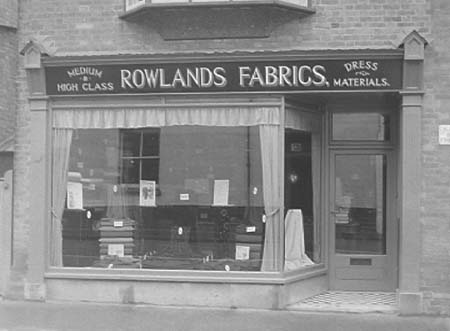
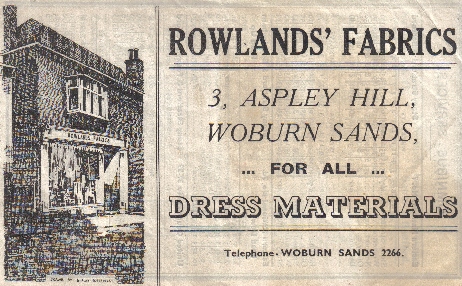
List of known Licensees: (note that this may not be a complete list)
????-1874: John Collins
1874-1874: Arthur Jenkyns
1874-1881: John Scott
1881-1883: Ebenezer Hankin (Ankins)
1883-1889: John Clark
1889-1889: Joseph Elice Chandler
1889-1890: George Kilsby
1890-1895: George Webb
1895-1899: George Woodhams
1899-1918: John Williams
1918-1921: Madeline Williams
1921-1926: John Ernest Chinn
1926-1927: Edward Cornelius Chandler
1927-1928: Edward Thomas Smith
1928-close: Lt. Col. Talbot Jarvis (License put into his name as a Director of Charles Wells Ltd)
Page last updated Dec. 2018.
